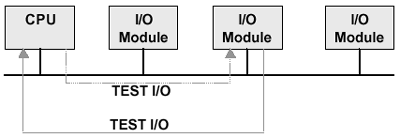|
(a) What is an interrupt? [2]
It is an asynchronous event that suspends
the CPU from its
normal operation [1] and jumps to a pre-programmed routine to
handle the interrupt. [1]
(b) Identify and explain the five I/O objectives. [5]
(One mark each, provided explanations are
given. If no
explanations are given, award up to [2] over all. )
CPU COMMUNICATION
CONTROL & TIMING
DEVICE COMMUNICATION
DATA BUFFERING
ERROR HANDLING
(c) The diagram below is a representation of one of the techniques
for determining an interrupt. Identify the technique and explain what
actions are being performed. [5]

The interrupt
technique is the: SOFTWARE POLL. [1] Here, the processor sends out
an instruction [1] to test the status register of the I/O module,
[1] which it duly returns to the processor. [1] If this is not identified
as the interrupting module, the processor will repeat the process
until the I/O module is identified. [1]
Award marks for other valid points. [5 marks]
(d) The technique of part (c) uses a
single channel architecture known as memory-mapped. What are
some of the disadvantages associated with using a single channel?
[3]
Attaching/ the assignment of priority to
I/O modules. [1 or 2] Resource sharing over the use of the System
Bus. [1 or 2]
(In each case, award [1] if the answer is heading in the right direction,
and [2] if it properly explains the issue. Of course, no one may score
more than [3] over all. Other reasonable answers are also acceptable)
|
